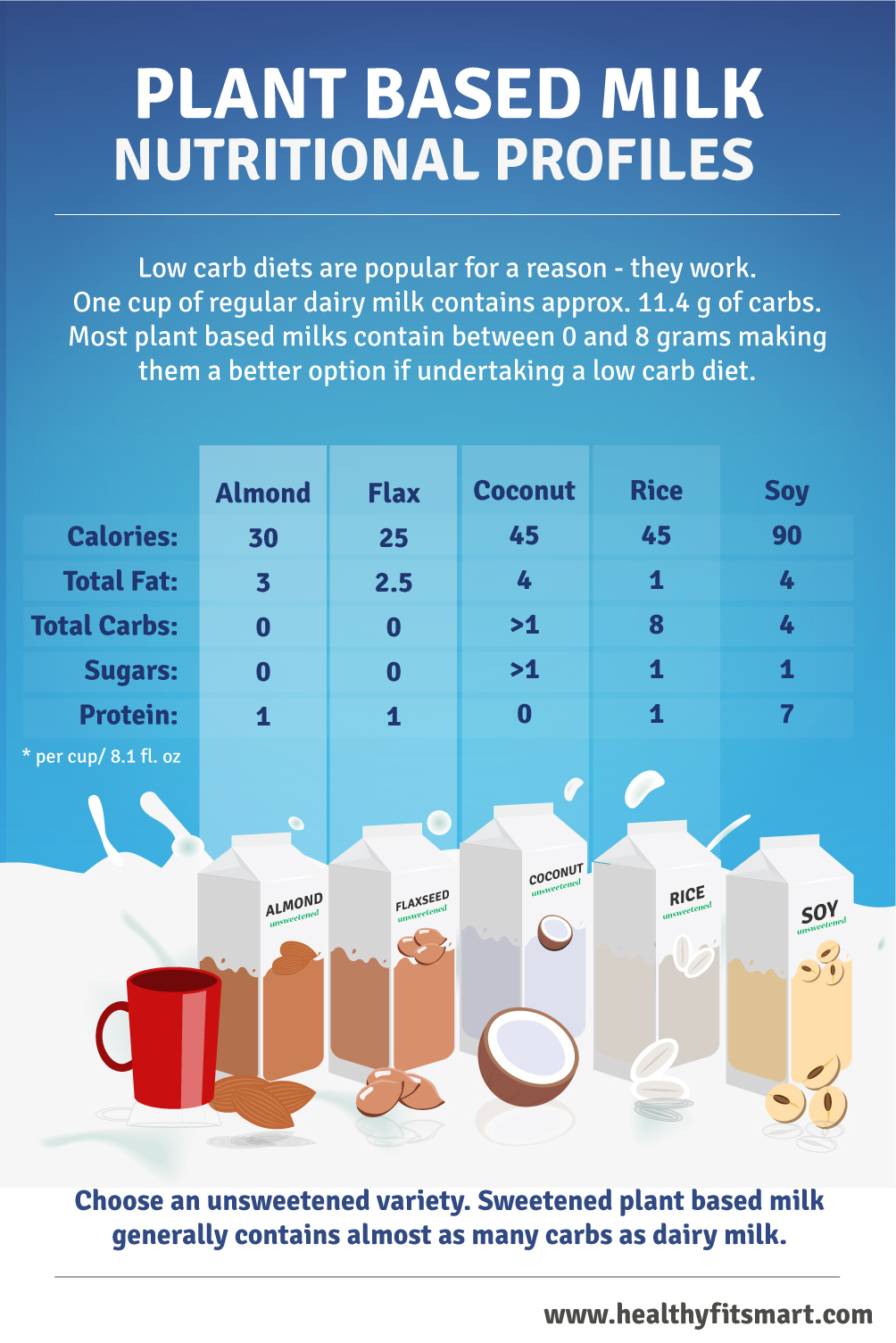The Short Answer:
Table of Contents
Low carb diets are popular for a reason, they work. In fact, a diet low in carbohydrates is considered twice as effective as a diet that is low in dietary fat. And while it’s still common practice to see ‘low fat’ emblazoned across packaged food labels on the shelves of your local supermarket, there are also a vast number of ‘low carb’ alternatives available including bread, ice cream, and even beer. But what about low carb milk? Are there viable low carb alternatives to traditional dairy milk? and if so, how appealing are they?
In the following article, we’ll take a closer look at some of the best low carb milk products available and give you our verdict, based on the nutritional profile, taste and consumer pros and cons.
 The Problem with Dairy Milk
The Problem with Dairy Milk
How many carbs are found in whole milk?
Whole milk contains on average approximately 12g of carbohydrates per cup (8 fl. Oz. / 244mm). The caloric breakdown of whole milk is on average approximately 49% Fat, 30% carbohydrate and 21% Protein.
If you consume a typical cereal based breakfast and enjoy between 2-3 cups of coffee per day (with milk) the number of carbohydrates you consume can begin to add up in the context of a standard western diet.
Carbs in Skim Milk
As you might imagine, low-fat/reduced fat or skim milk contains a slightly higher number of carbohydrates. The reason for this increase in the number of carbohydrates is due to the fact that once the fat is reduced the remaining macronutrients e.g. protein and carbohydrate content become higher in proportion.
What about Lactose-Free Milk?
Lactose-free milk contains the same amount of Carbohydrates as whole milk, despite being lactose-free. This can be confusing if unaware of how lactose-free milk is produced as the majority of carbohydrate content found in milk comes directly from Lactose.
Lactose for those unaware is a sugar present in milk comprised of glucose (the primary sugar metabolized by the human body) and galactose (a monosaccharide sugar, found in dairy products).
However, just because lactose-free milk does not contain lactose does not mean these sugars are removed. Lactose-free milk simply contains an enzyme that separates the glucose and galactose molecules, meaning the carbohydrate content is still as high as whole or reduced fat milk.
Low Carb Milk Alternatives

Share this Image On Your Site
Based on the quantity of carbohydrate found in whole, skim and lactose-free dairy milk, regular dairy milk is not a viable option for those wanting to consume a milk product low in carbohydrates.
This is difficult for those undertaking a low carb diet as milk is more or less a dietary staple for most people and is a component in the second most popular drink consumed in the world – coffee.
So what’s the answer?

While there are some dairy milk alternatives available that as part of the manufacturing process more or less extract most of the carbohydrate content, in most cases we need to look past the dairy industry and more directly at plant-based milk products, including the following:
- Almond Milk
- Soy Milk
- Flax milk
- Coconut Milk
- Rice Milk
- Hemp Milk
- Pea Protein Milk
- Oat Milk
Before you rush down to your local supermarket and stock up on one of the low-carb milk products listed above, it is important that you choose an unsweetened variety as almost all low carb milk products are available in both unsweetened and sweetened versions. Sweetened plant based milk generally contains almost as many carbs as dairy milk.[/box]
What is Fortified Low Carb Milk?
Most plant based low carb milk is fortified, meaning vitamins that the product is lacking are added during processing. This can be considered both a good and bad development based on your opinion. For one, obviously adding essential vitamins is beneficial for one’s health but there is evidence that suggests supplementation of calcium, for instance, may also increase the risk of heart disease .
Carbs in Almond Milk
 Unsweetened almond milk is a popular low carb milk alternative, with higher sales volume than soy milk which has waned in popularity in recent times. Almond milk is considered by many to be the best tasting plant based milk product and also contains zero carbohydrate content.
Unsweetened almond milk is a popular low carb milk alternative, with higher sales volume than soy milk which has waned in popularity in recent times. Almond milk is considered by many to be the best tasting plant based milk product and also contains zero carbohydrate content.
Almond milk is considered by many to be the best tasting plant based milk product and also contains zero carbohydrate content.
Almond milk is relatively simple to make and is typically produced by grinding almonds with water and then extracting the remaining almond content through a strainer.
Unsweetened Almond Milk Nutritional Profile
- Calories: 30
-
Total Fat:
3g
- Saturated : 0g
- Polyunsaturated: 1g
- Monounsaturated: 2g
-
Total Carbs:
0g
- Sugars: 0g
- Protein: 1g
Taste
As expected almond milk has a distinctly nutty flavor. Consumers often describe the taste as crisp and light. It typically has a thicker consistency than dairy milk and is relatively versatile, being equally effective as a dairy milk substitute in coffee and breakfast cereals along with baking. Like all low carb milk products, almond milk requires an adjustment period but for many is quite pleasant in coffee and on cereal.
Like all low carb milk products, almond milk requires an adjustment period but for many is quite pleasant in coffee and on cereal.
Pros:
- Lower in calories than dairy milk (30 calories for cup, compared to approx. 150 calories in whole milk)
- Fortified Almond milk is often a rich source of calcium and vitamin D
- Naturally high in vitamin E
- Considered a good source of iron
- Lactose-free.
Cons:
- In some cases, total almond content has been found to be only 2% and has resulted in several lawsuits
- Lacks much of the fiber and antioxidant content of almonds as it is removed during processing
- Can separate if left unattended for any length of time
- Almond milk contains phytic acid , which is known to limit mineral absorption.
Soy Milk
 Soy milk was
first introduced to the US market in 1979
. While it has remained popular, sales of almond milk now exceed that of soy milk. Soy milk is produced by soaking dried soybeans for at least three hours, then removing the water and skins of the soybean. It is then blended with water until a smooth texture is achieved.
Soy milk was
first introduced to the US market in 1979
. While it has remained popular, sales of almond milk now exceed that of soy milk. Soy milk is produced by soaking dried soybeans for at least three hours, then removing the water and skins of the soybean. It is then blended with water until a smooth texture is achieved.
Soy milk is produced by soaking dried soybeans for at least three hours, then removing the water and skins of the soybean. It is then blended with water until a smooth texture is achieved.
Unsweetened Soy Milk Nutritional Profile (1 cup/ 8.1 fl. oz)
- Calories: 90
-
Total Fat:
4g
- Saturated : .5g
- Polyunsaturated: 0g
- Monounsaturated: 0g
-
Total Carbs:
4g
- Sugars: 1g
- Protein: 7g
Taste:
Soy milk can differ in flavor depending on the origin of the soybeans used in the manufacturing process. It is often described as having a strong aftertaste and is generally a creamier consistency than almond milk. Opinions vary considerably regarding the overall taste, however, many find the taste difficult to adapt to after making the switch from regular dairy milk.
Opinions vary considerably regarding the overall taste, however, many find the taste difficult to adapt to after making the switch from regular dairy milk.
[box type=”info” size=”large”] Isoflavones, Good or bad?Soybeans contain high concentrations of Isoflavones. Isoflavones are a controversial topic and one worthy of further explanation. While Isoflavones are believed to have some associated health benefits ( according to studies ) the jury is still very much out on how safe they are. Isoflavones are classified as phytoestrogens. Phytoestrogens are compounds that bind to estrogen receptors, and as a result, have the ability to mimic estrogen which can be beneficial in reducing the impact of conditions caused by low estrogen e.g. osteoporosis but may also potentially contribute to conditions resulting from increased estrogen activity including reduced fertility and some reproductive tract cancers.
Phytoestrogens are compounds that bind to estrogen receptors, and as a result, have the ability to mimic estrogen which can be beneficial in reducing the impact of conditions caused by low estrogen e.g. osteoporosis but may also potentially contribute to conditions resulting from increased estrogen activity including reduced fertility and some reproductive tract cancers.
In summary, there are a number of pros and cons associated with Isoflavones, and these may be determined by variables we are yet to fully understand. The Cancer Council does support the consumption of soy-based products but neither supports nor recommends the use of soy-based supplements.[/box]
Pros:
-
Higher source of protein than almond milk (7g per cup compared to 1g)
- Soy Milk is also the only plant based protein that is considered a complete protein source e.g. it contains all 9 essential amino acids
- A rich source of vitamin B2 (Riboflavin) and Vitamin B12 which aids in red blood cell function.
- Lactose free
- May lower the risk of heart disease
- Low in cost.
Cons:
Soy products have their fair share of detractors with a number of health implications cited. I have included a number of these below
-
Soy food allergies are fairly common.
- Symptoms include skin reactions and abdominal pain
- Contains high levels of Phytic acid which limit mineral absorption
- 90% of soy-based products are genetically modified . You may feel strongly about GMO’s if so soy milk is a product you may prefer to avoid.
- Many people find the taste unappealing.
Flax Milk
 Flax milk is a relative newcomer to the low carb milk market when compared to soy and almond milk.
Flax milk is a relative newcomer to the low carb milk market when compared to soy and almond milk.
Flax milk is essentially cold pressed flax oil, combined with filtered water.
Unsweetened Flax Milk (1 cup/ 8.1 fl. oz) Nutritional profile
- Calories: 25
-
Total Fat:
2.5g
- Saturated : 0g
- Polyunsaturated: 1.5g
- Monounsaturated: 0g
-
Total Carbs:
1g
- Sugars: 0g
- Protein: 0g
Taste
Unsurprisingly, flax milk has a slightly nutty flavor and tastes much like flax seeds. The flavor is not as strong as other low carb milk varieties and could be considered more of a neutral, uncomplicated flavor that is a better option when used as an ingredient as opposed to a stand alone drink.
Opinion on the overall taste of flax seed milk is divided, with some claiming it is by far the best tasting low carb milk product available while others say the taste is far inferior to almond milk.
Pros:
- May control menopause symptoms
- Lower in calories than almond, soy, and Coconut milk.
- A source of omega 3 fatty acids (more information below)
- Creamy texture
Cons:
- As per soy, flax seeds contain Phytoestrogens (please see above for more information on Phytoestrogens).
- While flax seeds do contain omega 3 acids it should be noted that sources of omega 3 fatty acids such as seafood are utilized far more efficiently by the body in comparison)
- Low in calcium, unless it has been fortified.
Coconut Milk
Coconut milk has largely been promoted by the Paleo movement and is produced by extracting the white fleshy part of the coconut which is then grated and soaked in water. Coconut cream then floats to the top and is skimmed off leaving the coconut milk.
Unsweetened Coconut Milk (1 cup/ 8.1 fl. oz) Nutritional profile
- Calories: 45
-
Total Fat:
4g
- Saturated : .5g
- Polyunsaturated: 2.5g
- Monounsaturated: 1g
-
Total Carbs:
1g
- Sugars: 1g
- Protein: 0g
Taste
As you may have guessed, coconut milk tastes very much like coconut, although the taste is considerably weaker than you might expect.
Pros:
- Good source of Medium-chain triglycerides (saturated fatty acids) which are a good source of energy
- May boost your immune system thanks to its antimicrobial properties
- A good source of antioxidants which fight free radicals that may cause cellular damage in your body
- Good source of dietary fiber.
Cons:
- Higher in sugar content than soy, almond or flax milk
- Often sold in cans which raise a number of health concerns including the use of BPA’s and guar gums
- High caloric content which may result in weight gain
- May increase the effects of Irritable bowel syndrome (IBS)
The Best Low Carb Milk Option?
In my opinion, almond milk represents the best choice if you are in the market for a low carb milk product as a replacement for dairy milk. In comparison, it’s taste is more appealing than that of soy, coconut or flax milk and while soy milk has the edge when it comes to protein content, the concerns over phytoestrogens in both soy and flax milk, while inconclusive may be concerning for some. Almond milk is also significantly less calorically dense than coconut milk if you are watching your weight.
In comparison, it’s taste is more appealing than that of soy, coconut or flax milk and while soy milk has the edge when it comes to protein content, the concerns over phytoestrogens in both soy and flax milk, while inconclusive may be concerning for some. Almond milk is also significantly less calorically dense than coconut milk if you are watching your weight.
If however, you are not perturbed by the perceived concerns over phytoestrogens, then soy milk, if you can handle the taste is a good complete protein source and may be more beneficial depending on your requirements.
Where to Buy Low Carb Milk
The good news is, low carb milk is enjoying continued popularity and as a result can be found in most major supermarkets. Almond milk is particularly popular with brands including Silk , Pacific Beverages , and Blue Diamond Almond Breeze enjoying favorable reviews from consumers.
